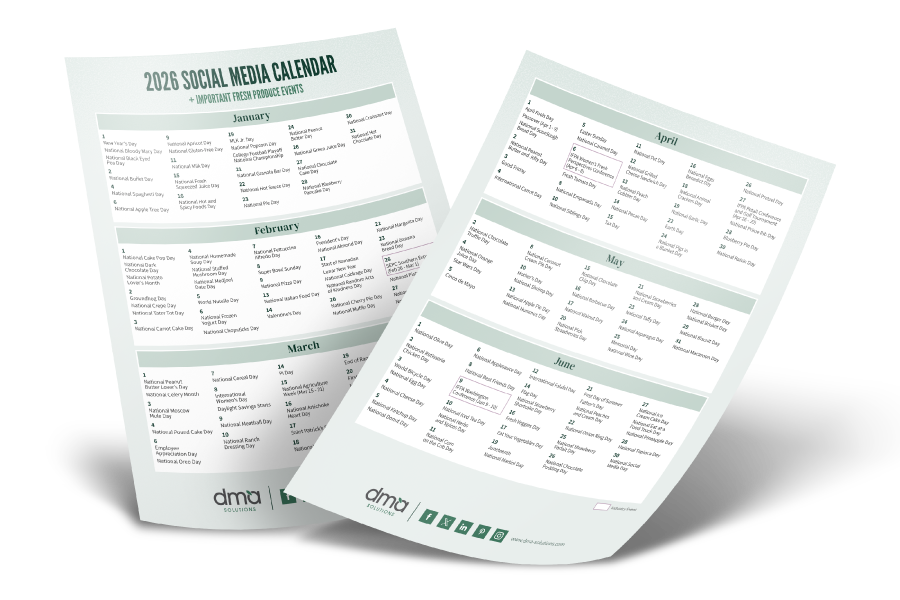As we’ve mentioned in previous posts, there is an inherent demand for fresh food, and it is going to sell with or without dedicated year-round marketing. In fact, choosing not to market your fresh produce is a strategy in and of itself, if your business has opted to operate a commodity. And hey, if that strategy is working for your brand today, that’s fantastic—however, it’s also important to recognize that choosing to operate without a thoughtful marketing plan can be disadvantageous to long-term growth.
How so? Well to start that conversation, we need to define what marketing is and what it is not.
Marketing’s Place in Fresh Produce
Marketing is: a unique strategic approach that incorporates data and insights in order to build awareness, consideration, and ultimately sales with a well-defined target audience. Marketing is not: a series of last-minute sprints to hit sales goals. At the end of the day, marketing is a marathon. It’s designed to help you craft and share your brand story, drive engagement, and build loyal customers over time.
Retaining commodity status, and thus choosing to remain beholden to price and availability alone, is one key risk companies run when electing to forego (or neglect) marketing efforts. Yet a far bleaker fate is experiencing continual loss of market share due to an unwillingness to adapt to market needs and expectations. (Ouch…I know.) But the good news is that choosing to invest in marketing today can have lasting positive impacts on your business!
So, how can you approach marketing strategically in order to drive real results? Below are 3 proven strategies to consider for long-term business growth:
3 Strategies for Using Marketing to Drive Business Growth
- Know your audience: creating a customer-centric approach to marketing is crucial. For instance, you may know how customers have traditionally shopped for your produce, but do you know how they prefer to shop for your product(s)? If you’re wondering how important that is, know this: 84% of people will not make a purchase if they are dealing with an unsecured website (Hubspot), and 33.5% of consumers are willing to pay more for “environmentally friendly” products (Nielson). It’s important to evaluate your current approach, identify gaps, and, ultimately, uncover opportunities for how best to engage your audience—and thus, learn how to cater to them in order to drive sales.
- At the end of the day, consumers trust the opinion of their peers more than they do statements by brands. In fact, people are 4 times more likely to buy when referred by a friend (Nielsen), and 92% of consumers report trust in peer reviews and recommendations online (Search Engine Watch). What does that mean for brands? To start, it’s a solid indicator that influencer programs, content marketing, and referral partnerships are making a significant impact on consumers. As a marketer, it’s well worth your time to consider whether these strategies may help with building a lasting name for your brand.
- Lead with video. Effective use of video content (link to investing in video content for 2020 post) to tell your story and create a consistent, cohesive brand image is a key driver of success. In fact, according to a recent study, video content is 50 times more likely to drive organic search results than plain text. (Source: Hubspot)
Marketing takeaway: you can start small with video, but as we approach the new year, commit to starting somewhere in 2020! Even short video content created with a clear and concise focus can help drive deeper brand loyalty.
Thoughtful marketing tactics drive equity and long-term brand success. As Seth Godin says, “If you want to change things, it helps to understand how humans make choices. And if you’ve got a change in mind, I hope you’ll spend the time and effort it takes to get better at bringing your story to the people who need to hear it.”
Therefore, changing your perception of what marketing can do is a great place to start when understanding its true impact. Instead of a “quick win” or a “sales booster,” we challenge you (and hopefully your sales team too!) to start viewing marketing as a thoughtful, strategic approach designed to build loyalty for the long-run. After all, marketing’s greatest impact is made when brands are able to develop a loyal fan base that exclusively chooses your product…this year, next year, and for many years to come.
Sources:
- Seth Godin’s Blog (2019): You Might Have a Marketing Problem: September 24, 2019, Retrieved from: https://seths.blog/page/3/
- Medium (2018): The Ultimate Guide to Marketing Trends in 2019, Retrieved from: https://medium.com/the-startup-growth/the-ultimate-guide-to-marketing-trends-in-2019-3d21bc5868e2
- Nielson (2019): Total Consumer Report 2019, Retrieved from: https://www.nielsen.com/us/en/insights/report/2019/total-consumer-report-2019/
- Search Engine Watch (2017): Six Stats on The Importance of Trust in Influencer Marketing, Retrieved from: https://www.searchenginewatch.com/2017/02/21/six-stats-on-the-importance-of-trust-in-influencer-marketing/
- Hubspot (2019): The Ultimate List of Marketing Statistics for 2019, Retrieved from: https://www.hubspot.com/marketing-statistics
- Nielson (2019): Brands increase trust—and prices—through sustainability, Retrieved from: https://www.nielsen.com/us/en/insights/article/2019/brands-increase-trust-and-prices-through-sustainability/
Have something to add? Leave us a comment below or reach out to us on Twitter @TheCoreBlog!
{{cta(‘32699105-97e4-4e13-a0af-fc31e29ca446’)}}

